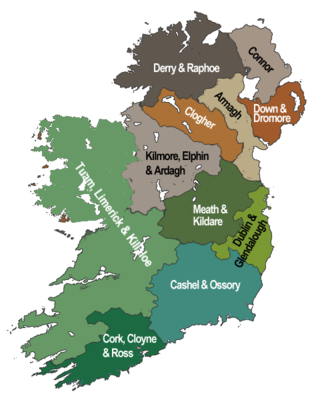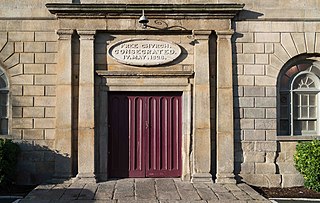
St Mary's Church, Dublin is a former Church of Ireland building on the corner of Mary Street and Jervis Street, Dublin, adjacent to Wolfe Tone Square. From the 17th century, the church was a place of worship for parishioners on Dublin's northside, before it was closed in 1986. The church has since been deconsecrated and the building is now a pub and restaurant. The parish also had a chapel of ease - St Mary's - off Dorset Street, more commonly known as "The Black Church".

St Audoen's Church is the church of the parish of Saint Audoen in the Church of Ireland, located south of the River Liffey at Cornmarket in Dublin, Ireland. This was close to the centre of the medieval city. The parish is in the Diocese of Dublin and Glendalough. St Audoen's is the oldest parish church in Dublin and is still used as such. There is a Roman Catholic church of the same name adjacent to it. In 2012 the parish was merged with St. Catherine and James Church on Donore Ave.

St. Nicholas Within is a former Church of Ireland parish church in Dublin city, Ireland. It was located at the corner of Nicholas St. and Christchurch Place, where part of its entrance may be seen next to the Peace Park. The term may also refer to the civil parish in the barony of Dublin City which was one of nine and a half baronies in the old County Dublin.
The Rev. James Whitelaw BA, MRIA was an Irish historian, writer, statistician, Anglican priest and philanthropist.

The Sick and Indigent Roomkeepers Society in Dublin, Ireland, is the city's oldest surviving charity.
The Priory of All Hallows was a monastic foundation just outside of the walls of Dublin, Ireland.
Hugh Inge or Ynge(c. 1460 – 3 August 1528) was an English-born judge and prelate in sixteenth century Ireland who held the offices of Bishop of Meath, Archbishop of Dublin and Lord Chancellor of Ireland.
Additional information needed
Walter de Islip, Isleep or de Istlep was an English-born cleric, statesman, and judge in fourteenth-century Ireland. He was the first Chief Baron of the Irish Exchequer; he also held the offices of Treasurer of Ireland, Chief Escheator, and Custos Rotulorum of Kilkenny. He was a noted pluralist, who held numerous benefices. His career was seriously damaged by accusations of corruption and maladministration. He played an important role in the celebrated Kilkenny Witchcraft Trials of 1324.

The De Meones, or de Moenes family were an Anglo-Irish family who originated in East Meon in Hampshire. They moved to Ireland in the late thirteenth century, became substantial landowners in Dublin and Meath, and gave their name to the suburb of Rathmines.

Dame Lane is a narrow thoroughfare in Dublin, Ireland, with a variety of historical and literary associations.
Thomas Augustine Geary was an Irish composer, pianist and organist, with a precocious talent particularly in vocal and piano writing.

The Archdeacon of Dublin is a senior ecclesiastical officer within the Anglican Diocese of Dublin and Glendalough. The Archdeacon is responsible for the disciplinary supervision of the clergy within the Dublin part of the diocese, which is by far the largest.

Nicholas Queytrot (t) (c. 1475 – c. 1550), also called Nicholas Greytrot or Nicholas Coitrotte, was a wealthy merchant and citizen of Dublin city in the sixteenth century, who served one term as Mayor of Dublin in 1523-4.
Roger Bekeford was a member of Dublin Corporation in the later fourteenth century, serving as bailiff on two consecutive terms from 1368 to 1370, and once as mayor in 1384. He is a witness to grants in 1371, 1373, 1382, and 1390 along with the mayor and bailiffs suggesting he was a prominent member of the Common Council. Further evidence for his standing comes from a note of him as one of the gentlemen of counsel for the city of Dublin on 18 October 1381, and again in 1385 he is empaneled on a jury looking into the Tolboll Custom claimed by St. Thomas’ Abbey.

Free Church, Great Charles Street, Dublin was a proprietary episcopal chapel in Summerhill, off Mountjoy Square in Dublin.

High Street is a street in the medieval area of Dublin, Ireland.
Thomas Snetterby was an Irish barrister, King's Serjeant and Crown official of the fifteenth century. He was remembered long after his death for giving his name to Snetterby's orchard near Kevin Street, Dublin.
Nicholas de Meones or de Moenes was an Irish judge of the fourteenth century. He had a somewhat turbulent career, due to his political partisanship, and was briefly imprisoned on a charge of treason.











